Where would music be without sampling?
We’ve built our entire Splice Sounds catalog on it, after all. While some samples might sound great from the moment they’re dragged into your DAW, the creative possibilities open up infinitely once you start employing sound design to flip them and make them your own. In celebration of the powerful sampling plugin Serato Sample’s release on Rent-to-Own, today we’re highlighting three artists who have demonstrated unique and useful sampling techniques that might offer inspiration for your next track.
1. Create synths out of sound effects like Chuck Sutton
Can anything be turned into a synth? Allow Chuck Sutton to show you the way. In the mind-boggling video that veteran production duo Brasstracks shared on Twitter below, he takes a one-shot of a grocery bag hitting a table and manipulates it to create a gritty, violin-sounding lead. Playing around with your DAW’s sampling and processing tools and, most of all, keeping an open and experimental mindset when approaching your sounds can help you achieve some interesting results like Chuck Sutton’s.
2. Complement samples with foley layers like Tennyson
Allow Tennyson to stretch your imagination for a moment – and chop, reverse, and flip it, too. In the video below, Luke Pretty of Tennyson has no real acoustic bass in the room (or the right software emulation) to work with. So what does he do? He applies a little creative foley. Watch as he layers a bass with a rubber band pluck to simulate the distinctive timbre of a double bass. With just a bit of EQing and layering, he’s able to transform an ordinary Massive bass into a realistic, acoustic-sounding one.
3. Get experimental with the source audio like Virtual Riot
Virtual Riot is an artist who’s respected not only for his incredible sound design chops, but for his eagerness to share his knowledge with the producer community. For example, in the video below, Virtual Riot shows us how he approaches sampling drums from start to finish – from attaching all sorts of percussive materials to acoustic snare drums in the recording stage to alternating slightly varied one-shots of the same sound in the DAW to prevent repetitiveness.
Did the artists above inspire a new creative idea for you? Who do you look to when experimenting with sampling techniques and sound design? Let us know in the comments below.
Take your own sampling to the next stage with Serato Sample:
December 8, 2020

.svg)
.svg)




